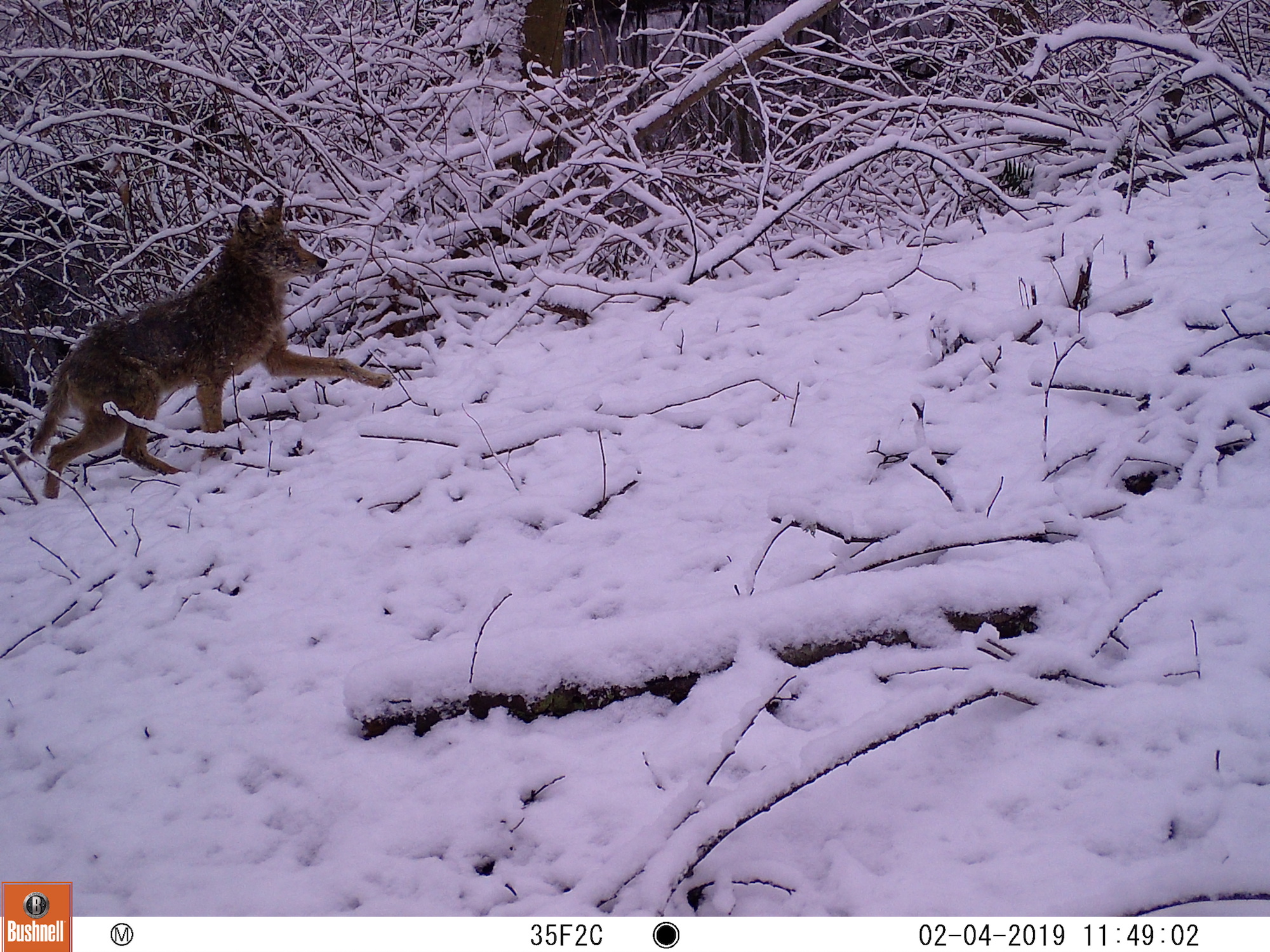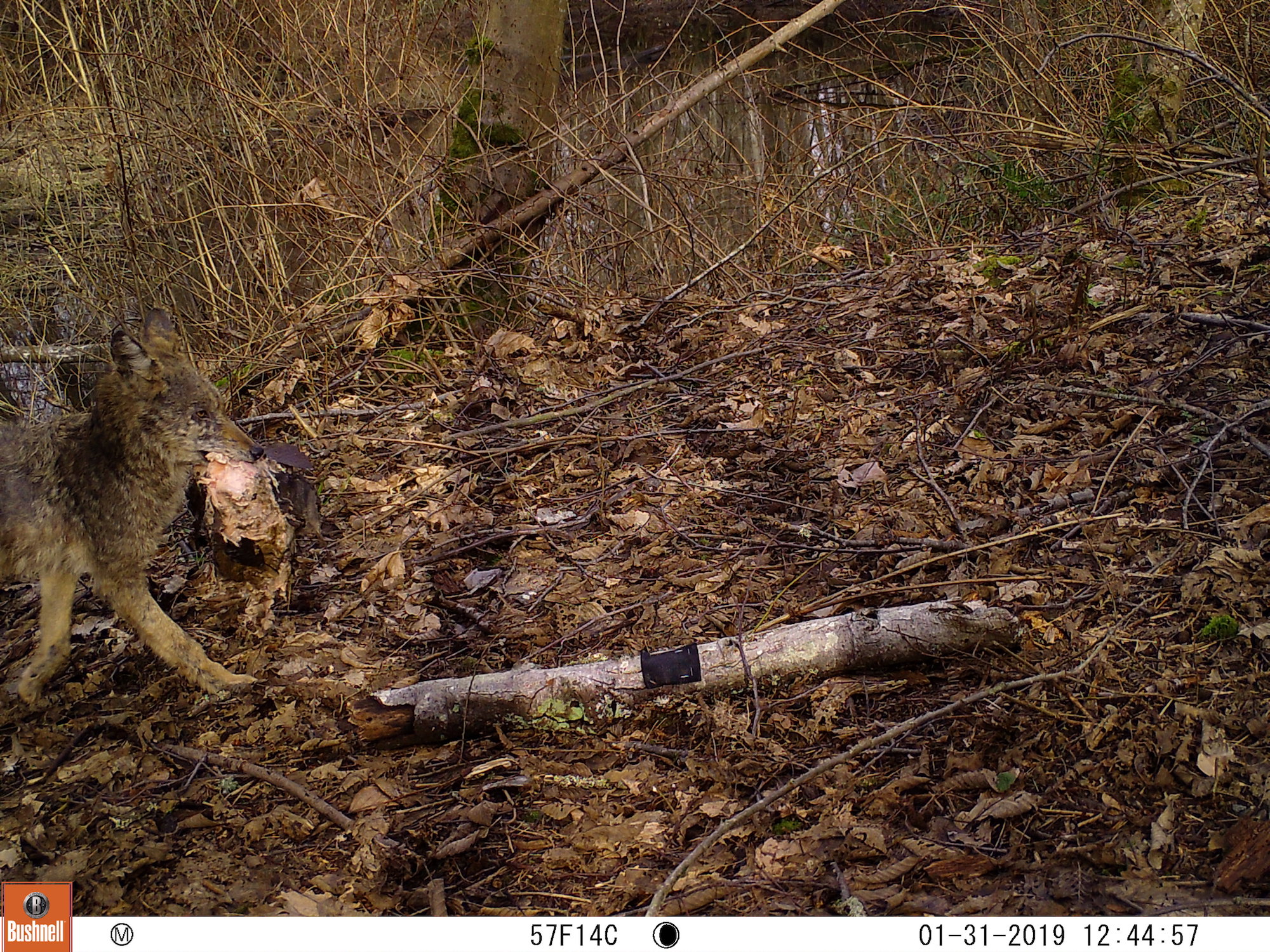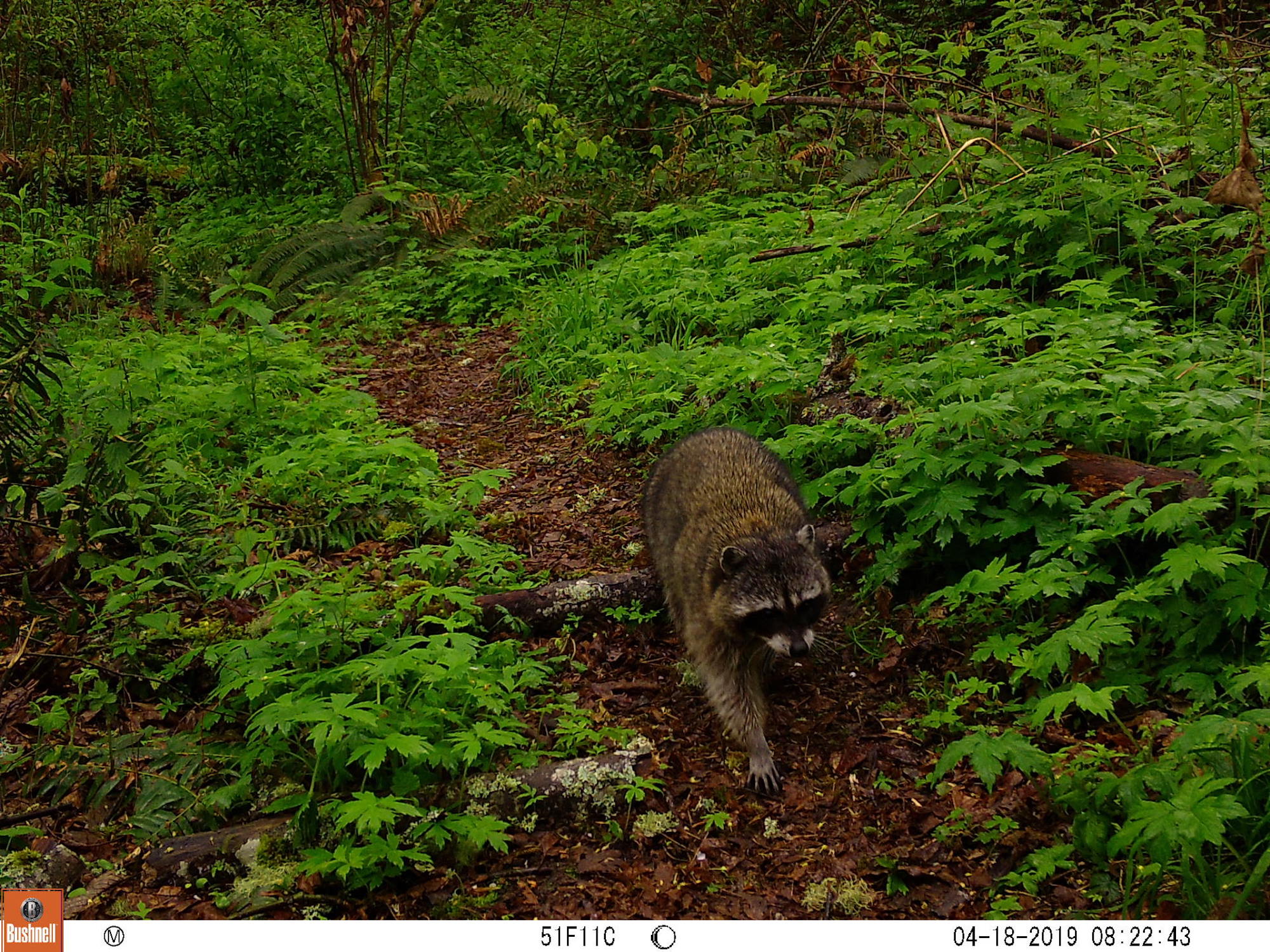
Seeing himself
in the science
Seeing himself
in the science
Seeing himself
in the science
Ecologist Christopher Schell believes that tapping into who he is as a person makes his research better.
Story by Julie Davidow | Photos by Quinn Russell Brown | December 2019
Christopher Schell will tell you he’s a black nerd. He’ll tell you he was up at 3 a.m. the night before a conference because his infant son would not sleep. He’ll tell you the students who work in his lab at the University of Washington, Tacoma are paid rather than expected to volunteer. He’ll tell you social and economic inequality is an ecological issue.
And he’ll tell you that studying the behavior of coyotes in cities reveals how race and class shape the neighborhoods and natural environments where people and animals live.
For Schell, an urban ecologist, recognizing all of these realities at once and sharing his story—all of his story—is crucial to challenging expectations about what a scientist looks like, sounds like, acts like and prioritizes. “Just being about the science is not good enough,” he told a roomful of wildlife experts in June.
Schell’s talk at the opening session of the International Urban Wildlife Conference in Portland wove pop culture references—including the films “Jurassic Park” and “Black Panther”—and social- justice critiques into an argument about the inextricable links between the social and natural sciences. “You’ve become part of a bigger universe. You just don’t know it yet,” he said, quoting Nick Fury, Samuel L. Jackson’s character from the movie “Iron Man.” “Does that sound familiar? It should. It’s very much like ecology,” Schell says.
Schell, who joined UW Tacoma last year as an assistant professor, is determined to use the charismatic species he studies to deliver a message about racism and inequality. As his work and interests have evolved, Schell says he finds it harder to ignore that everything is connected. If you pull one lever, another moves. That’s how he can get from urban wildlife to social justice in just a few steps. “If I can tell you that coyotes are linked to racism,” he says, “I got your ear.”
Although he is cautious about drawing direct connections—there is a history of scientific racism associating people of color with animals—he does see coyotes and the human reaction to them in urban areas as a metaphor. African Americans also are often met with fear and suspicion, he says, especially when they’re perceived as being somewhere they do not belong.
“I liken [coyotes in urban areas] to the experience of being black in America because they’re hyperpolarizing,” Schell says. “They’re hated on. They’re feared. People try to eradicate them from an environment. They don’t leave. They learn quickly and figure out ways to survive in cities.”
Below: Christopher Schell downloads footage from a motion-activated trail camera, which he uses to track urban coyotes around Tacoma.
Schell grew up in Altadena, a Southern California suburb just north of Pasadena where residential streets lined with adobe-roofed homes back up to canyons and wilderness. Cougars, raccoons and coyotes share the landscape with human beings. He loved animals and grew up hiking the trails with his family’s dog.
He was a smart kid, good at school and science. For a middle-class black college student with professional aspirations, that meant pursuing a pre-med track when he started at Columbia University. The respect and financial security of becoming a doctor seemed like a safe bet, especially when compared to a career in the natural sciences. Plus, the scientists on the nature shows he liked to watch were all white men. “If you have no cultural touch points to somebody who does work in the field, how would you know it’s an option?” he says.
Except, as he soon realized after volunteering at a hospital, he hated studying medicine.
So he changed his major to psychology, found an adviser in animal behavior, flirted with a focus on wolves and ultimately opted to study coyotes—a less well understood and more adaptable species of canid. He finds their ability to adjust to new surroundings “exceptionally endearing.”
“Coyotes are big enough to be the apex predator in cities,” he says, “but still small enough to navigate those cities.”

The skull of an adult coyote, measuring a mere four inches wide.
At its most fundamental level, urban ecology is the study of how people and nature interact. The field is relatively new, launched in earnest about two decades ago. It is an area of scientific research that lends itself, perhaps more than most, to a deeper understanding of the ways cities take shape around human priorities that benefit some people and animals more than others.
In Portland, wildlife scientists from around the world shared their research on topics like foraging behaviors of urban otters in Singapore, the impact of light pollution on tree frogs in Syracuse and conflicts between birds of prey and humans in Sao Paulo, Brazil.
Urban ecologists who ignore the geography of race and income in a city do so at the peril of their science as well as to the detriment of the people who live there, Schell told them. “If you only measure species in rich environments and make inferences across the city, you’re missing the point,” he says. “There’s in-city variance that’s influenced directly by social inequality.”
Redlining, for example, divided cities by race and income, relegating people of color to areas with fewer resources. Homeowners in more affluent neighborhoods planted trees and gardens, creating green environments that are healthier for people and attract a greater variety of urban wildlife.
By recognizing inequalities that persist today in urban areas, “we do our science better,” Schell said.
- M2E76L217-217R399B418
- M2E15L11-11R350B320

- M2E68L199-199R399B413
- M2E48L135-135R395B381
Above: Surrounding Christopher Schell are three coyotes and a raccoon, caught on camera courtesy of Schell in collaboration with Karen Povey, ’01 (Point Defiance Zoo & Aquarium) and members of the Grit City Carnivore Project.
The audience, scientists whose careers are dedicated to studying wildlife in the least wild of settings like street corners in the Bronx and Chicago city parks, was hooked. They cheered in person and gushed on social media.
“Thank you @cschell_canids for one of the most inspirational talks I’ve heard at a wildlife meeting in years! Way to show us how and why representation matters,” Madhusudan Katti, an evolutionary ecologist at North Carolina State University, wrote on Twitter.
Sharon J. Hall, an ecosystem ecologist at Arizona State University, posted that the opening session was “one of the most authentic conversations about inclusion I’ve experienced in a conference setting.”
The topics of diversity and inclusion are often relegated to specific panels at large conferences, says Travis Gallo, an urban ecologist at George Mason University. When the Portland organizers gave Schell and Gallo the go-ahead to plan a full day on those topics, “We just ran with it,” Gallo says. They invited Deeohn Ferris, vice president for Equity, Diversity and Inclusion at the National Audubon Society, and Bob Sallinger, director of the Portland Audubon Society, to join Schell on stage.
“Urban ecologists who ignore the geography of race and income in a city do so at the peril of their science.”
Christopher Schell, Assistant Professor

During the Q&A, a professor asked the group how he could help a graduate student get through a program in which she is the only African American. Schell said he’s been there. He watched the number of students of color studying ecology alongside him dwindle from five when he was an undergrad to one in graduate school. And that person eventually dropped out. “It’s lonely sometimes,” he said.
Then Schell told a story.
While driving back to the University of Chicago from his fieldwork in Utah, he was pulled over by the Highway Patrol. It was a routine stop—license, insurance, do you know how fast you were going—with a twist. The officer told him to wait in the patrol car while he asked Schell’s then-girlfriend (now his wife), who is white, some questions. He wanted to know how long the two of them had been a couple, did they live together, were they married, did they have children.
“It had nothing to do with the science, but it hurt,” Schell recalled. “It still hurts to this day.”



For Schell, being a research scientist is about fieldwork, teaching and publishing. But it is also about supporting students of color who feel out of place and overlooked in predominantly white classrooms. And it means helping set an environmental-justice agenda based on the needs and priorities of marginalized communities.
To those multiple ends, Schell tries to live his ideals.
Last fall, Schell’s lab launched the Grit City Carnivore Project with the Point Defiance Zoo & Aquarium, Northwest Trek and Metro Parks Tacoma. The long-term research project recruits scientists to track and collect data about Tacoma’s urban wildlife. He’s also working with a new group of other researchers in his department at UW Tacoma to understand how Tacoma residents in the city’s racially diverse neighborhoods define the most pressing environmental issues in their communities.
And when students come to him afraid that they don’t belong, he is frank about his own struggles. “I think about how to be as vulnerable and authentic with them as possible. I tell them straight up, ‘Look, sometimes I cry in my office. It’s damn hard. Sometimes, the kids didn’t sleep,’ ” Schell explained in Portland. “I let them know that I am human. I am flawed. I make mistakes. And you all can do that in my office, too.”
Schell’s openness set the tone for a different kind of conversation than is typical in academic settings. “I had never seen Chris speak before,” Gallo said. “He blew me away. I had goosebumps.”
Schell feels a kinship with coyotes—and not just because he watched pups grow up during his graduate work. A framed photo of the puppies from his study—with their big ears, playing in the dry grass—hangs on his office wall. On the shelf below, an empty raccoon cage hints at his next project.
Schell knows he moves through the world as a suspect, much like the animals he observes. So he adapts. He smiles more. He carefully selects his clothes—a sport coat and collared shirt rather than the cargo pants and flannel so common among older, white ecologists. He never goes out to do fieldwork alone. “I’m not scared of coyotes, but [hearing] cop sirens when I have an anesthetized animal at 3 a.m.—that’ll raise my hackles.” He wears a jacket that says “Point Defiance Zoo & Aquarium staff,” which “gives me some credibility beyond just being a black person out in nature.”
Before the 1920s, North American coyotes lived exclusively in the Great Plains. But after wolves were hunted almost to extinction, coyotes expanded their territories and are now found throughout the country, pushing past rural areas and deep into cities. There’s even a sizable population in Manhattan.
Schell, who keeps a life-size replica of a coyote in his office, explains that they fall between wolves and foxes on the canid carnivore food chain, but loom much larger in the popular imagination—both in size and threat. Adults weigh an average of 25 pounds and are about the size of border collies, although their winter coats can make them appear much bigger. Wolves, by comparison, weigh up to 120 pounds. And though they do hunt cats and small dogs (domestic cats make up 20 percent of an urban coyote’s diet, according to one estimate), they almost never attack people.
When humans spot coyotes hunting in backyards and trotting down residential streets, they often suspect the canids are out of place and up to no good. They rarely ask which human habits—outdoor cats, pet food on the porch, roads and new homes covering what was once open space—encourage coyotes to stick around and adapt, Schell says.


A coyote at Tacoma Nature Center, photographed by Zachary Hawn of Point Defiance Zoo & Aquarium.
Experts already knew that urban coyotes were bolder around people than their rural counterparts when Schell started his graduate work. But they did not know why. After observing eight coyote families at a federal research facility in Utah, Schell found that coyote pups learn not to fear humans by watching their parents. “Each generation is bolder than the last,” he says. “Soon you have a litter of puppies that, by the time they become adults, are city slickers.”
If Schell notices a coyote too close to homes or a nature trail, he walks toward it, clapping and shouting. Coyote specialists call this hazing and it’s the best way to head off conflict with humans. Those canid encounters might endanger people, but are more likely to end in removal or death for the coyotes, Schell says. “If we do this hazing as a community, making sure the animals have a healthy fear and caution around people, then they survive longer, the population stays healthy, and we still have coyotes in our city without fearing them.”
As a young, black ecologist, Schell believes he has an edge. He’s already more practiced than most scientists at modulating his message based on the audience. He sees connections and possibilities where others see discrete conditions and natural divisions. He wants to be an ambassador for his field, a bridge between urban ecology, sociology, history and urban studies.
“That code-switching is something that urban ecology should adopt,” Schell says. “Traditional ecologists marveled at how wildlife adapted and completely ignored the inequality that exists in cities.
“I feel like it’s my calling and my job to say, ‘Let’s reconsider this.’”





